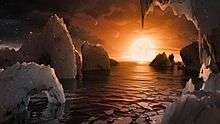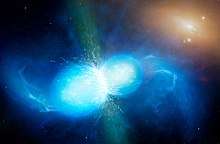2017 MB7
2017 MB7 is a trans-Neptunian object and damocloid on a cometary-like orbit from the outer Solar System, approximately 6 kilometers (4 miles) in diameter. It was first observed on 22 June 2017 by the Pan-STARRS survey at Haleakala Observatory in Hawaii, United States.[1] The unusual object has the largest heliocentric aphelion of any known minor planet, even larger than that of 2014 FE72; it is calculated to reach several thousand AU (Earth-Sun) distances at the farthest extent of its orbit.
| Discovery [1] | |
|---|---|
| Discovered by | Pan-STARRS 1 |
| Discovery site | Haleakala Obs. |
| Discovery date | 22 June 2017 (first observed only) |
| Designations | |
| 2017 MB7 | |
| TNO [2] · damocloid [3] unusual [4] · distant [1] | |
| Orbital characteristics [2] | |
| Epoch 27 April 2019 (JD 2458600.5) | |
| Uncertainty parameter 2 | |
| Observation arc | 174 days |
| Aphelion | 6,081.842±281.760 AU |
| Perihelion | 4.456 AU |
| 3,043.149±140.990 AU | |
| Eccentricity | 0.9985 |
| 167,878±11,670 yr | |
| 0.0053° | |
| 0° 0m 0.021s / day | |
| Inclination | 55.718° |
| 58.246° | |
| 80.635±0.002° | |
| TJupiter | 1.4760 |
| Physical characteristics | |
Mean diameter | 6 km (assumed)[3] |
| 0.09 (assumed)[3] | |
| 14.156±0.332[2] 14.2[1] | |
Orbit and classification
2017 MB7 orbits the Sun at a distance of 4.5–6,082 AU once every 167,878 years (semi-major axis of 3043 AU). Its orbit has an eccentricity of 0.9985 and an inclination of 56° with respect to the ecliptic.[2]
As it has an eccentricity higher than 0.50, the distant object is labelled an (other) unusual object by the Minor Planet Center.[4] The Johnston's Archive groups it to the damocloids,[3] due to its extreme orbital elements and a TJupiter of less than 2, while in JPL's Small Body Database, it is a trans-Neptunian object with a semi-major axis larger than that of Neptune.[2]
| Orbital evolution — Barycentric elements | |||
| Year[5] (epoch) | Aphelion | Semimajor-axis | Orbital period |
|---|---|---|---|
| 1600 | 2000 AU | 1000 AU | 33,000 yrs |
| 2017 | 1600 AU | 780 AU | 22,000 yrs |
| 2400 | 2800 AU | 1400 AU | 54,000 yrs |
It is by far the most distant and eccentric known asteroid orbiting the Sun, varying in its distance from the Sun over its orbit by 99.89% from slightly within the orbit of Jupiter, to more than 7,000 times Earth's distance to the Sun. While its orbit extends to the inner Oort cloud, it may not be a member of it, as it approaches very near to Saturn, implying Saturn has either captured a past Oort Cloud object onto this orbit, or it was a centaur ejected by Saturn from a much smaller orbit. However, it would be impossible to project its orbit far enough into the past to determine which scenario is true.
Like most objects on an extremely distant orbit around the Sun, 2017 MB7's barycentric orbit is very different from its heliocentric orbit, the latter being based only on the current position of the Solar System barycenter, and the former is based on the long-term movement of the barycenter. While the heliocentric aphelion is 7,000–9,000 AU, depending on the calculation, the current barycentric aphelion (as of 2018) is only 1,700 AU. Before its perihelion in 2016 AD (after that of ~30500 BC), it reached 2,000 AU from the sun around ~14300 BC.
Physical characteristics

Very little is known for certain about the body's physical characteristics. The Johnston's Archive assumes a generic distant-object albedo of 0.09 and calculates a diameter of 8 kilometers.[3] Like other distant objects, it is probably also fairly red in appearance due to tholins on its surface.
References
- "2017 MB7". Minor Planet Center. Retrieved 19 November 2018.
- "JPL Small-Body Database Browser: (2017 MB7)" (2017-12-13 last obs.). Jet Propulsion Laboratory. Retrieved 19 November 2018.
- Johnston, Wm. Robert (7 October 2018). "List of Known Trans-Neptunian Objects". Johnston's Archive. Retrieved 19 November 2018.
- "List Of Other Unusual Objects". Minor Planet Center. 14 November 2018. Retrieved 19 November 2018.
- Horizons output. "Barycentric Osculating Orbital Elements for 2017 MB7". Retrieved 25 February 2018. (Solution using the Solar System Barycenter and barycentric coordinates. Select Ephemeris Type:Elements and Center:@0)
External links
- 2017 MB7 at AstDyS-2, Asteroids—Dynamic Site
- 2017 MB7 at the JPL Small-Body Database


